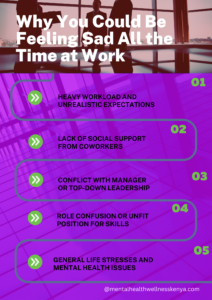It's Monday morning, and as your alarm goes off, you feel a tightness in your stomach. You don't want to get out of bed, much less drag yourself into work.
You hit snooze a few times before forcing yourself to get ready, but you have no energy or excitement about the day ahead.
Upon arriving at the office, you let out a sigh and try to motivate yourself to dive into your tasks. But you can't focus.
All you feel is overwhelming sadness.
The feeling follows you throughout the day, making every project seem tedious and every interaction draining.
By the time you get home, you're exhausted from trying to mask how down you feel. You wonder—why do I feel so sad all the time at my job? What's wrong with me?
In the sections that follow, we will discuss various reasons why you could be feeling sad while at work. Afterwards, we will suggest ways to overcome the sadness so that you can thrive at work.
Heavy Workload and Unrealistic Expectations

Feeling overwhelmed by endless work demands can definitely lead you to feel sad all the time at work.
When the workload exceeds what any employee can reasonably manage, it creates constant workplace stress that wears people down day after day.
Tasks pile up quicker than you can complete, and resources are too scarce to lighten the load. You must work long hours, power through without breaks, and always rush to keep up.
Take Ann, for example.
Ann was excited when she was hired as a customer service representative at a large retail company.
But over the years, staffing was cut back while demand rose. Suddenly, Ann had to handle three times as many customer inquiries with less support.
The company also updated their returns process with condensed timelines that didn't account for the rise in orders.
Despite working 10–12 hour days without lunch breaks, Ann couldn't keep pace anymore. She made errors in return out of pure exhaustion. Even when she processed fifty returns flawlessly each day, managers critiqued her for not meeting their standard of eighty.
Ann felt constant anxiety about falling behind and overwhelming stress from the pressure to do more with unrealistic deadlines. With time, it eroded Ann's confidence and motivation.
Minor issues at work began triggering emotional breaks where Ann felt hopeless. The unachievable demands drained all her positivity.
A job Ann used to enjoy now causes her endless sadness due to the extreme output required and impractical standards set. Could Ann’s story be similar to yours?
Lack of Social Support from Coworkers
Having positive social connections at work is extremely important for your happiness on the job. But without a supportive team around you, it can be isolating and lead to sadness.
Let’s use your current role as an example.
You may be working by yourself in a cubicle all day without much interaction with colleagues. You occasionally need to collaborate with others or require help, but your coworkers dismiss your requests or provide little assistance.
In the breakroom, you eat lunch alone while others talk and joke at tables together. Attempts to socialize end abruptly or remain superficial. The lack of interest makes you feel excluded and invisible.
Over time, you dread coming into an office where no one acknowledges or interacts with you beyond basic functionality.
It begins to affect your motivation and performance since you don’t feel part of the team. You start taking more sick days just to avoid the regular isolation and indifference from peers.
Studies show having positive workplace relationships correlates strongly to job satisfaction and engagement.
But without quality friendships or mentors around you, work becomes filled with loneliness and sadness.
Having no social support can gradually make an otherwise decent job an unhappy emotional burden.
Conflict with Manager or Top-Down Leadership Approach

Few things can drain your workplace happiness faster than leadership conflicts.
Having an overly authoritarian or rigid manager leads many employees to grow unhappy over time, even in roles they initially enjoyed.
When the top leadership makes all the decisions by themselves and discourages feedback instead of displaying trust or flexibility, it disempowers employees below.
People don't feel free to come up with creative solutions or make choices aligned with realities on the ground.
As time passes, the strict top-down approach can transform engaged workers into rule-based employees who merely clock in to work like robots.
The following table compares the characteristics of top-down and bottom-up leadership.
| Top-Down Leadership | Bottom-Up Leadership |
| Decisions made unilaterally by leadership | Decisions made collaboratively incorporating staff input |
| Rigid procedures and rules dictate operations | Flexibility to meet on-the-ground realities |
| Information flows one way–from top to bottom | Open communications in all directions |
| Management closely monitors and micro-manages | Empowers employees through trust |
| Staff assume set roles like robots | Staff encouraged to showcase creativity |
| Few questions or constructive criticism allowed | Critical thinking and reasonable difference of opinion encouraged |
| Staff mainly comply out of obligation | Staff feel invested ownership over operations |
| Disengaged workforce over time | Boosted engagement and morale over time |
| Breeds employee resentment and sadness | Promotes employee fulfilment and positivity |
When your workplace is like the characteristics outlined in the first column, you will likely feel frustrated and unsatisfied. The thought of going to work and being at work may cause unending sadness.
Role Confusion or Unfit Position for Skills
Finding yourself in a job that doesn’t match your talents can be demoralizing. When there is role confusion or your duties don’t align with your strengths, it slowly breeds unhappiness.
Let's consider Otieno’s work situation.
Otieno first started working at a marketing firm in a manager role that played to his skills in building client relations and overseeing projects through leadership abilities.
But, after some time, the company began assigning Otieno additional responsibilities in graphic design, data analytics, and writing reports that failed to match his expertise as a relationship builder and organizational leader.
Otieno signed on to guide collaborative efforts between teams, support staff needs, and foster external partnerships.
However, the company now allocates him tasks such as creating visual assets, working on detailed metrics reports, and drafting technical copy.
Though eager to add value, he lacks any background in these creative and analytical areas outside a manager’s oversight role.
Bit by bit, Otieno dreads coming to work, knowing his days will be filled with tasks for which he has no foundation or natural talents.
Team members see their once confident leader frustrated. His initial high engagement gets eroded by self-doubt and inadequate preparation for what are now considered “core” duties.
The role confusion leaves Otieno feeling constantly out of his depth, leading to constant sadness.
Reflect on Otieno’s situation and ask yourself, does your role at work match your skills?

General Life Stresses and Mental Health Issues
It's common to think that feelings of sadness at work are only caused by job issues. But stresses in regular life can make work problems even harder to deal with and cause frequent sadness. Examples of tough personal situations include:
- Financial troubles
- Family conflict
- Parenting challenges
- Death of a loved one
- Big life changes
- Health issues
In addition, mental health struggles like depression, anxiety, PTSD, or bipolar disorder can also make job frustration feel even worse when trying to balance everything.
For example, undergoing chemotherapy treatments during business travels adds physical and emotional strain well beyond the normal job scope.
Having a special needs child at home in crisis care while handling sensitive clients triples the pressures.
Even smaller pains, like addressing ageing parents' health declines or losing a beloved pet, can add more emotional challenges to an already tough work situation.
Without proper help carrying these outside and inside burdens, you end up feeling much sadder over time.
How to Overcome Feeling Sad All the Time at Work
Feeling down or depressed at work happens. Do not beat yourself down for being human.
When sadness feels constant despite your efforts, it can drain purpose and performance. However, there are proactive ways to relieve workplace unhappiness, regardless of the triggers. They include:
- Evaluate and address potential root causes. Whether workload issues, poor work relationships, role confusion, or lack of growth opportunities.
- Improve communication with leadership to seek compromises aligning expectations with reality.
- Form supportive bonds with friendly colleagues to reduce isolation.
- Practice regular self-care through getting enough sleep, eating healthy food, exercising, praying, and having a positive work-life balance.
- Consider whether aspects of company culture or values ultimately align with personal fulfillment and explore job options.
- If general anxiety, trauma, grief, mental health struggles or life stresses add to work issues, seek help from mental health and counseling professionals.
Mental Health Wellness Kenya offers therapy sessions to employees struggling with challenges inside and outside the workplace.
We help clients understand themselves better, work through the various issues in their lives, and cope with their job situation. Book your first appointment with us today.

